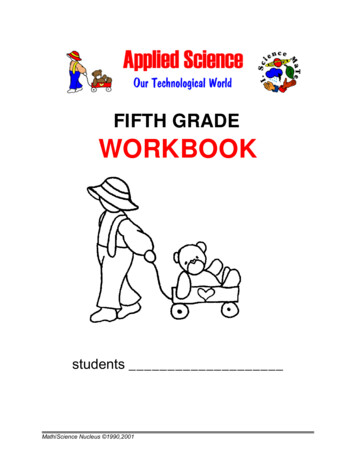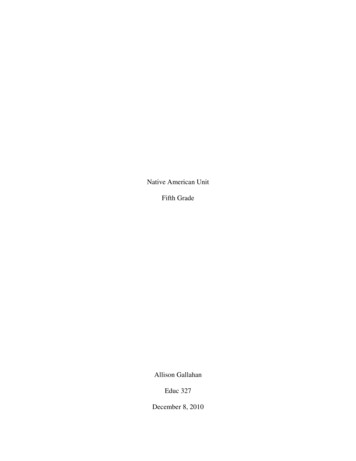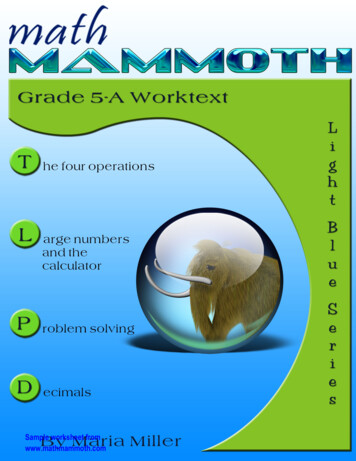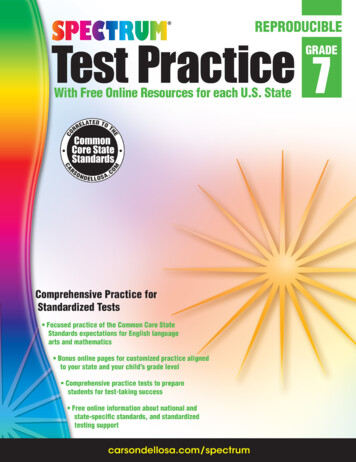
Transcription
FIFTH GRADEWORKBOOKstudentsMath/Science Nucleus 1990,2001
APPLIED SCIENCE - SCIENCE AND MATH (5A)PROBLEM: Can you learn how to estimate?PREDICTION:MATERIALS: 3 containers filled with items given to you by your instructorPROCEDURE:For each container: (1) estimate the number of items that are in the container andrecord, and (2) count the actual number of items it took to fill the container and record.Complete one container at a time. Record the results below.ITEM123ESTIMATIONACTUAL NUMBERPlot the above data as a bar graph on the chart below as accurately as possible.The difference between the actual number and the number estimated is the margin of error(how far off the estimation was). Color the margin of error a separate color. Make the xaxis estimation/actual number, and y axis the number of items.CONCLUSIONS: Summarize your findings. Discuss your margin of error for eachcontainer. Were you close?Math/Science Nucleus 1990,20012
APPLIED SCIENCE - SCIENCE AND MATH (5A) POSTCALIFORNIA'S POPULATION, 1900 - 20001. Connect the dots to make a LINE GRAPH.2. From 1900 to the year 2000, has California's population increased or decreased?3. During the year 1970, what was California's population?4. Assuming the extrapolation the data from 1990 to 2000 is accurate, from 1960 to theyear 2000, will California's population double or triple?5. What will be the population in California in the year 2040, if its population growthcontinues at the rate shown in the graph above? How did you figure out the answer?Math/Science Nucleus 1990,20013
APPLIED SCIENCE - SCIENCE AND MATH (5B) PREMEASUREMENT OF YOUR BODYUse a ruler or tape measure and record your measurement in centimeters.cmhand spanright footleft footright earsmile widthbetween eyesright armleft armarm spanhead size (girth)heightwristMeasure other parts you might want to know.Math/Science Nucleus 1990,20014
APPLIED SCIENCE - SCIENCE AND MATH (5B)Math/Science Nucleus 1990,20015
APPLIED SCIENCE - SCIENCE AND MATH (5B)ASTIGMATISMMath/Science Nucleus 1990,20016
APPLIED SCIENCE - SCIENCE AND MATH (5B)PROBLEM: How many students in the class have better than 20/20 (6/6) eyesight?PREDICTION:MATERIALS: Snellen eye chart, astigmatism chartMeasure 20 feet (6 meters) away from the eye chart. Have your partner stand on thatline. Point to several of the lines on the chart and record which lines they can see andwhich ones they cannot. Tabulate what eyesight you think the student has. Have yourinstructor check your conclusion. Use your partner's lab sheet to record theinformation.Partner who is recordingEYELINES THAT CAN BE READLINES THAT CANNOT BE READleftrightbothFigure out your eyesight for "both" eyes.Look at the astigmatism chart. Describe what you see. Do you have astigmatism?After the class is finished with testing, the teacher should find out the following by ahand count. Record the class results.GIRLSBOYSless than 20/2020/20more than 20/20CONCLUSION:Math/Science Nucleus 1990,20017
APPLIED SCIENCE - SCIENCE AND MATH (5B)1. Below are pictures of the eye. Label each part of the eye from information derivedfrom your research.Write down the websites or books that helped you discover more about diseases of theeye.Math/Science Nucleus 1990,20018
APPLIED SCIENCE - SCIENCE AND MATH (5C) PRESOMETHING INTERESTING ABOUT SOUNDSound is everywhere. We know when someone opens the door or when you areon the beach. The sounds are different. Can you explain sound. Use any book,encyclopedia or ask a knowledgeable person.Math/Science Nucleus 1990,20019
APPLIED SCIENCE - SCIENCE AND MATH (5C)PROBLEM: How can you determine if sound is a physical wave?PREDICTION:PROCEDURE:MATERIALS: 6 jars (same size); water, stick, tuning forksEXERCISE I. Stretch a rubber band to different lengths and describe what happens tothe pitch of the soundEXERCISE II. Hit the tines of the tuning fork on a hard surface and touch the tines tothe items listed below. Record what happens and see if you can hear the tuning fork.ITEMWHAT HAPPENSCAN YOU HEARnosehandnailpaperpencilpensurface of waterother:EXERCISE III. Using 6 jars, fill each with the appropriate amount of fluid in the chartbelow. Record the type of sound produced when you tap it with a drumming stick.Describe the quality of the pitch.JAR CONTENTSDESCRIPTION OF SOUNDA. emptyB. 1/4 fullC. 1/3 fullD. 1/2 fullE. 2/3 fullF. 3/4 fullCONCLUSIONS: Do the above experiments illustrate that sound is a physical wave?What else did you learn?Math/Science Nucleus 1990,200110
APPLIED SCIENCE - SCIENCE AND MATH (5C)Math/Science Nucleus 1990,200111
APPLIED SCIENCE - PHYSICS (5A)PROBLEM: How can you distinguish between diffraction, reflection, and refraction ofwaves?PREDICTION:PROCEDURE: Go to the different stations and determine if the wave is physical orelectromagnetic. Perform the activity and determine whether you are showingdiffraction, reflection or refraction. Remember LASER SAFETY.PHYSICAL ORELECTROMAGNETICDESCRIBEMOTIONSTATION 1. Pencil inglass of waterSTATION 2. Use laserslits in aluminum foil 0, 2and 5 mm apartSTATION 3. Tuning forkin pie tin half full of waterSTATION 4. Spoonhitting surface of waterSTATION 5. Slinkymotion (push pull)STATION 6. RopeoscillatingSTATION 7. Flashlightthrough prismSTATION 8. MirrorSTATION 9. Flashlightthrough convex lensSTATION 10. Turboyo-yoCONCLUSIONS: How did you detect the different type of wave motion?Math/Science Nucleus 1990,200112
APPLIED SCIENCE - PHYSICS (5A)ELECTROMAGNETIC WAVESThe illustrations below demonstrate most electromagnetic waves that we know.Frequency of a wave is the number of vibrations in a given time (measured in Hertz).The higher the frequency the smaller the wavelength, the lower the frequency thelarger the wavelength.1. Which wave has the highest frequency?2. Which wave has the lowest frequency?3. Which wave can we see? Circle and label this light on the diagram.4. Which wave can we hear? Why isn't this wave on the chart?5. Which wave can take a picture of your bones?6. What uses microwaves?7. Where do television waves come from?8. Where do radio waves come from?Math/Science Nucleus 1990,200113
APPLIED SCIENCE - PHYSICS (5B)PROBLEM: How does a kaleidoscope work?PREDICTION:PROCEDURE: Materials: ruler, tape, silver mylar sheets, 3/4 oz plastic cup, toiletpaper tube, paper towels1. Measure 3 pieces of 2.5 cm by 10 cm piece of silver mylar that your teacherwill provide. If you have a different size tube consult your teacher. Join the 3 pieces ofsilver mylar into a triangular prism. MAKE SURE YOU PUT THE SHINY SURFACEINSIDE. Tape the triangular prism together. (see picture below)2. Put a small number of colored beads or any other materials in the plastic cup.Record what you put in your kaleidoscope. Position the cup in one end of the toiletpaper tube. Put the lid on the cup.3. Wrap the triangular prism in paper towel (you may need 2 or 3 sheetsdepending on the thickness of the towel) so it fits snugly in the tube.Point the tube toward a light source and rotate the plastic cup as you lookthrough the open end of the tube. You have just made a kaleidoscope. List what andhow many items you put in your kaleidoscope.LOOK AT YOUR KALEIDOSCOPE. Draw what you see in the tube without turning it.How many sections is it divided into?Look through your partners kaleidoscope. Is it different from yours? How?CONCLUSION: Why do you think a kaleidoscope works. Explain?Math/Science Nucleus 1990,200114
APPLIED SCIENCE - PHYSICS (5B) POSTREFLECT OR REFRACT?Trace the path of light from the different lenses. Note where the light source isand if there is mylar. Remember mylar will reflect light.Math/Science Nucleus 1990,200115
APPLIED SCIENCE - TECHNOLOGY (5A)Lasers are neat! It almost seems like the photons of light have joined together to makea powerful and beautiful tool. The term “laser” really is a condensed word meaning:Light Amplification by Stimulated Emission of Radiation.The above picture shows how light from helium and neon can become a laser light.Can you explain?List some places or items where you may have hear the word laser and write themdown.Which one of the following is the type of pattern generated by laser? Which one isproduced by sunlight?Coherent light wave patternMath/Science Nucleus 1990,2001Incoherent light wave pattern16
APPLIED SCIENCE - TECHNOLOGY (5A)PROBLEM: Is there a difference between light from a laser and a flashlight?PREDICTION:MATERIALS: lens, prism, cube magnifier, ulexite, quartz, mirror, laser, flashlightPROCEDURE: IF YOU ARE USING THE LASER, LISTEN TO YOUR TEACHER'SINSTRUCTIONS. LASERS ARE NOT TOYS AND MUST BE HANDLED WITH CARE.DO NOT STARE AT LASER LIGHT!Shine the light of the flashlight through your items. If theroom is not dark, use a black piece of paper as the backing soyour images will show up. Record what you see. If you areusing a laser, shoot one of the beams through the samematerial and draw what you see in the appropriate space below.ITEMFLASHLIGHTLASERPRISMQUARTZULEXITECUBE MAGNIFIERMIRRORBICONVEX LENSCALCITECONCLUSION:Math/Science Nucleus 1990,200117
APPLIED SCIENCE - TECHNOLOGY (5A)FIND DIFFERENT TECHNOLOGIES THAT USE LASERS?Use the Internet to search “lasers” and list the different products that you can find.Many of you have seen holograms. Many stickersthat “flicker” are actually holographic images. Thereare artists that specialize in holograms. Hologramsare made by lasers. But how are they made.Search the web for “holograms” and see if you canunderstand what and how holograms are made. Thepicture and information below were found searchingthe web. After your search, see if you can explainhow a hologram is made with your own words. Writethem down in the space provided.HOW IS A HOLOGRAM MADE?The custom artwork is then sent to ourholography laboratory where the holographercreates and combines the necessary photographic and holographic elements toproduce a "master" hologram on special photosensitive emulsions.As with all holograms, the multidimensional image is recorded as a unique"interference pattern" which is created using laser light and precision opticaltechniques.Math/Science Nucleus 1990,200118
APPLIED SCIENCE - TECHNOLOGY 5BCOMPARING HOW LIGHT IS USED IN A MICROSCOPE1. Draw the Swift GH in the space below and label the appropriate parts.2. Define the function of the following parts.ARMCONDENSEREYEPIECEOBJECTIVESTAGE3. Trace how light goes through an object and through the optic tube of thetransmitting light figure and the Swift GH figure you drew.Math/Science Nucleus 1990,200119
APPLIED SCIENCE - TECHNOLOGY (5B)PROBLEM: Do people focus differently using the same objective on the microscope?PREDICTION:MATERIALS: reflecting microscope, ruler, 5 objects, lens, index cardPROCEDURE:EXERCISE I. Find the optical element-image distance. Using a convex lens anda source of light (near a window), create an inverted image. Look at diagram below.Measure the distance from the inverted image (or index card) to the lens. Record youranswer and compare it with the image your partner found.YOUR DISTANCE:PARTNER’S DISTANCE:EXERCISE II. Look at 5 objects under the microscope. When each object is focused,measure the distance from the object to the objective. Record the focal distance in thegraph below. Compare with 2 other groups and see if the focal distance is the same ornot. Write your observations under the conclusions.Specimen UsedYour DataGroup 1Group 2CONCLUSIONS: Is the focal distance the same for all objects? How did you provethis?Math/Science Nucleus 1990,200120
APPLIED SCIENCE - TECHNOLOGY (5B) POST LABHOW THE EYE SEES IMAGESMath/Science Nucleus 1990,200121
APPLIED SCIENCE - BUILT ENVIRONMENT (5)In the first 2 columns on this chart, write down the types of sounds you hear in24 hours and the sources of those sounds. For each sound on your list, decide thedecibels of that noise. Then decide how necessary each noise is (somewhat, or not atall). Finally, make suggestions for reducing the noises on your list in the propercolumns.jet airplane, 100 feet awayair raid siren, nearbyrock music, amplifiedriveterbusy street trafficconversation in homequiet radio in homewhisperrustle of leavesthreshold of hearingSOUNDSOURCEMath/Science Nucleus 1990,2001DECIBEL140 db125 db120 db95 db70 db65 db40 db20 db10 db0 dbHOWNECESSARYHOWREDUCED22
APPLIED SCIENCE - BUILT ENVIRONMENT (5)PROBLEM: Are all light bulbs the same inside? Why or why not?PREDICTION:MATERIALS: 4 different light bulbs, microscopePROCEDURE: Look at light bulbs at your station and draw the inside of the bulb. Youmay use a microscope. Make sure that the filament is 5.5 cm away from the objective.Remember the bulbs are glass. HANDLE WITH CARE. Label the following: glass,filament. Trace the flow of the electrons through the light bulb in each of the pictures.Your teacher has a light bulb that is producing light. Look and see if you candetermine what produces the light. Use the following space to make notes.CONCLUSIONS: Why do light bulbs have different filaments?Math/Science Nucleus 1990,200123
FIFTH GRADE WORKBOOK students _ Math/Science Nucleus 1990,2001 2 APPLIED SCIENCE - SCIENCE AND MATH (5A) PROBLEM: Can . Math/Science Nucleus 1990,2001 3 APPLIED SCIENCE - SCIENCE AND MATH (5A) POST CALIFORNIA'S POPULATI










